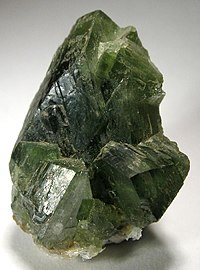| Ludlamite | |
|---|---|
 | |
| General | |
| Category | Phosphate mineral |
| Formula (repeating unit) | (Fe,Mn,Mg)3(PO4)2·4H2O |
| IMA symbol | Lud[1] |
| Strunz classification | 8.CD.20 |
| Crystal system | Monoclinic |
| Crystal class | Prismatic (2/m) (same H-M symbol) |
| Space group | P21/a |
| Unit cell | a = 10.541(5), b = 4.646(4) c = 9.324(5) [Å]; β = 100.52°; Z = 2 |
| Identification | |
| Color | Apple-green to bright green |
| Crystal habit | Tabular crystals; massive, granular |
| Cleavage | Cleavage: perfect on {001}, indistinct on {100} |
| Mohs scale hardness | 3.5 |
| Luster | Vitreous, pearly on cleavage |
| Streak | Pale greenish white |
| Diaphaneity | Translucent |
| Specific gravity | 3.12–3.19 |
| Optical properties | Biaxial (+) |
| Refractive index | nα = 1.650 - 1.653 nβ = 1.669 - 1.675 nγ = 1.688 - 1.697 |
| Birefringence | δ = 0.038 - 0.044 |
| 2V angle | Measured: 82° |
| References | [2][3][4] |
Ludlamite is a rare phosphate mineral with chemical formula (Fe,Mn,Mg)3(PO4)2·4H2O. It was first described in 1877 for an occurrence in Wheal Jane mine in Cornwall, England and named for English mineralogist Henry Ludlam (1824–1880).
Occurrence[edit]
It occurs in granite pegmatites and as a hydrothermal alteration product of earlier phosphate bearing minerals in a reducing environment.[4] It occurs associated with whitlockite, vivianite, triploidite, triplite, triphylite, siderite, phosphoferrite, fairfieldite and apatite.[2]
References[edit]
- ^ Warr, L.N. (2021). "IMA–CNMNC approved mineral symbols". Mineralogical Magazine. 85 (3): 291–320. Bibcode:2021MinM...85..291W. doi:10.1180/mgm.2021.43. S2CID 235729616.
- ^ a b Mindat.org
- ^ Webmineral.com
- ^ a b Handbook of Mineralogy
External links[edit]
![]() Media related to ludlamite at Wikimedia Commons
Media related to ludlamite at Wikimedia Commons